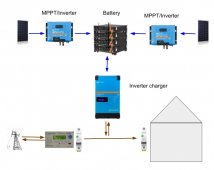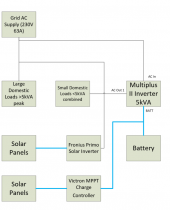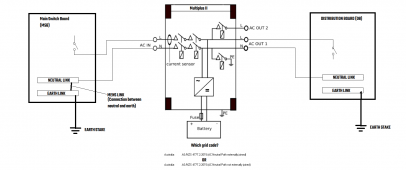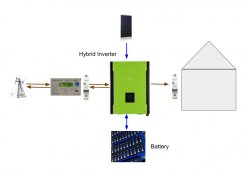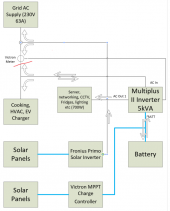I'm looking to build a hybrid system at my home, with the goal of reducing my power bills and learning a lot in the process.
I have managed to source some batteries for very cheap through work. They are VRLA and were about 45kWh when new and I'm banking on them being about half that now. I plan to replace them with LiFePo4 cells once they are totally worn out.
I plan to install 6-8kW of solar panels in the next year or so (need to replace my roof first), but because I'm getting these batteries in the next few weeks I want to design my system now as I need to purchase something to keep these batteries charged in the mean time.
I have been trying to work out the best way to design my system, and have come up with the two different arrangements below..
I quite like the idea of going with all Victron equipment as it seems fairly popular in my country and I like the attitude of the company (they have published lots of useful information, and their interface software seems to be open source)
I have a few questions I was hoping someone could answer for me.
Would either of these work? I'm not 100% sure if the Multiplus inverter can be grid tied or not?
Which arrangement would be the most efficient or most optimal?
I am an electrical engineer so I have a good understanding of the theory etc, so I'm just trying to get familiar with the capabilities of all the different equipment.
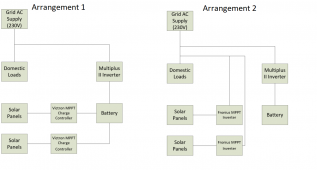
I have managed to source some batteries for very cheap through work. They are VRLA and were about 45kWh when new and I'm banking on them being about half that now. I plan to replace them with LiFePo4 cells once they are totally worn out.
I plan to install 6-8kW of solar panels in the next year or so (need to replace my roof first), but because I'm getting these batteries in the next few weeks I want to design my system now as I need to purchase something to keep these batteries charged in the mean time.
I have been trying to work out the best way to design my system, and have come up with the two different arrangements below..
I quite like the idea of going with all Victron equipment as it seems fairly popular in my country and I like the attitude of the company (they have published lots of useful information, and their interface software seems to be open source)
I have a few questions I was hoping someone could answer for me.
Would either of these work? I'm not 100% sure if the Multiplus inverter can be grid tied or not?
Which arrangement would be the most efficient or most optimal?
I am an electrical engineer so I have a good understanding of the theory etc, so I'm just trying to get familiar with the capabilities of all the different equipment.






